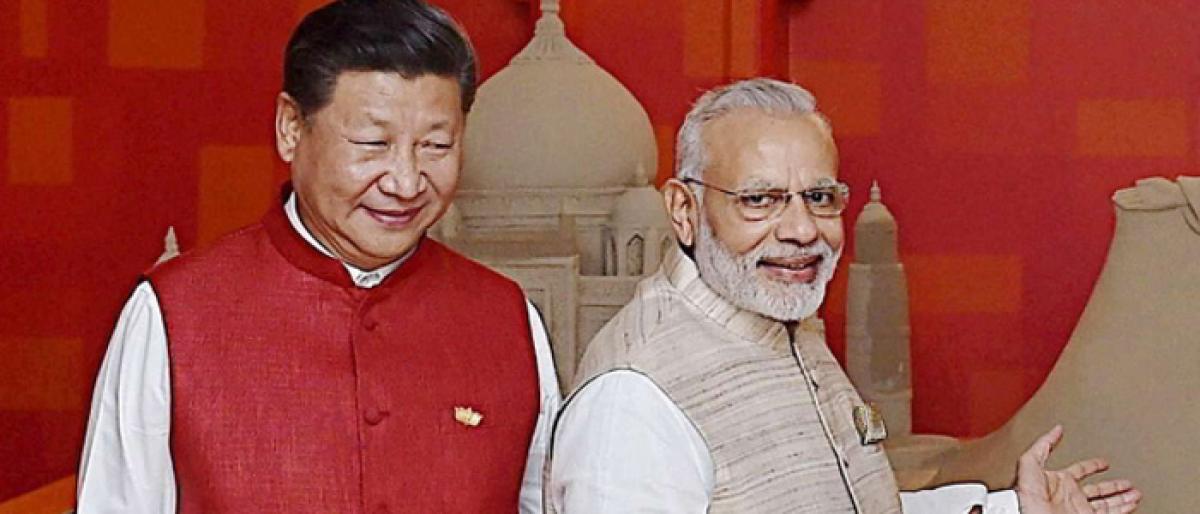Live
- Ticket distribution: AAP's public feedback on 70 seats
- Since YSRCP Boycotting Assembly Session: Alliance MLAs told to play Opposition role too
- Reliance invests big in AP
- 2024 on track to be hottest year on record
- PM Modi’s visit to Solapur: Women applaud ‘Double-Engine’ government’s initiatives
- Nagarkurnool MLA Dr. Kuchukulla Rajesh Reddy Campaigning in Maharashtra Elections
- Wife Kills Husband with Her Lover: Details of Veldanda Murder Case Revealed by SP Gaikwad
- Strict Action on Violations of Food Rights: Telangana Food Commission Chairman Goli Srinivas Reddy
- Smooth Conduct of Group-3 Exams with Strict Security Measures: Collector Badavath Santosh
- Delhi HC orders cancellation of LOC issued against Ashneer Grover, wife
Just In

The leaders of India and China are set to make their boldest attempt yet at rapprochement in talks this week just months after a dispute over a stretch of their high-altitude Himalayan border rekindled fears of war.
New Delhi/Beijing: The leaders of India and China are set to make their boldest attempt yet at rapprochement in talks this week just months after a dispute over a stretch of their high-altitude Himalayan border rekindled fears of war.
Prime Minister Narendra Modi is flying to the Chinese city of Wuhan for two days of talks with President Xi Jinping from Friday, mostly without aides, officials say, aimed at ending decades of distrust that has deepened as China, with an economy five times bigger than India’s, asserts itself in the region.
Their differences are significant: as well as disputes over stretches of a 3,500 km (2,200 miles) border, the Asian giants are bumping up against each other in the Indian Ocean and squabbling over Xi’s signature Belt and Road infrastructure initiative.
India signalled as recently as Tuesday its opposition to the grand trade and transport plan because one of its branches runs through Pakistani-administered Kashmir, which India claims.
For its part, China has been concerned about US efforts to draw India into a maritime “quad” of democracies, including Japan and Australia, in a part of the world they have begun calling the “Indo-Pacific” instead of the “Asia-Pacific,” which to some places China too firmly at the centre. At the same time, pressure over trade that US President Donald Trump has put on China is driving its efforts to improve ties with others facing the heat from Trump, including India.
China needs to get India on its side, said Hu Shisheng, director of the Institute of South and Southeast Asian and Oceania Studies at the China Institutes of Contemporary International Relations, a state-backed think-tank.
“As far as the United States is concerned, the Indo-Pacific is crucial, and for China, the Indo-Pacific is aimed at China. So China needs to win India over as much as possible,” Hu said.
Both sides have stressed this is an informal meeting rather than a summit - without the pomp and flag-waving children - as a way, hopefully, get more done.
“It can provide a comfortable atmosphere for the two countries’ leaders to have full and deep exchanges on important issues of mutual concern,” said Chinese Foreign Ministry spokesman Lu Kang, days after the announcement of Modi’s trip, which will be followed by another to China in June for a regional conference.
Chinese state television said in a commentary that often, more gets done at informal meetings, when people can speak their minds. It pointed to the success of informal talks Xi had with then-U.S. President Barack Obama in 2013 in California.
Indian officials said there was no agenda and the two would likely address “misunderstandings” that had festered for years and escalated into a 73-day military face-off on a wind-swept Himalayan plateau last year.
“There is a realisation on both sides that we need greater communication at the highest political level,” said an Indian government source. Both countries have recently sought to accommodate each other’s concerns.
Last month, India issued an unprecedented ban on Tibetans holding a rally with the Dalai Lama in New Delhi to mark the 60th anniversary of a failed uprising against Chinese rule.
China regards the Tibetan spiritual leader who lives in exile in an Indian hill town as a dangerous separatist. For its part, India was pleased when China dropped its objections to international efforts to put India’s arch foe, Pakistan, on a “grey list” of counties deemed to be making inadequate efforts to tackle terrorist financing.
China has long stood by Pakistan with political and military support, a sore issue for India which accuses Pakistan of harbouring terrorists. Pakistan denies that. Ahead of the talks, China reassured Pakistan their relations were as firm as ever and would “never rust.”
The stakes are high for the world’s two most populous countries, which went to war in 1962 and continue to ramp up forces on either side of their border. China claims more than 90,000 sq km (35,000 sq miles) ruled by India in the eastern Himalayas. India says China occupies 38,000 sq km (14,600 sq miles) of its territory on the Aksai Chin plateau in the west.
Wang Dehua, director of the Centre for South Asia Studies at Shanghai’s Tongji University, said the talks should help heal the wounds of last year’s border dispute. “The Indian people should recognise that China is not a threat. Improving ties has only advantages for India,” Wang told the official Jiefang Daily.
By: Sanjeev Miglani & Ben Blanchard

© 2024 Hyderabad Media House Limited/The Hans India. All rights reserved. Powered by hocalwire.com







